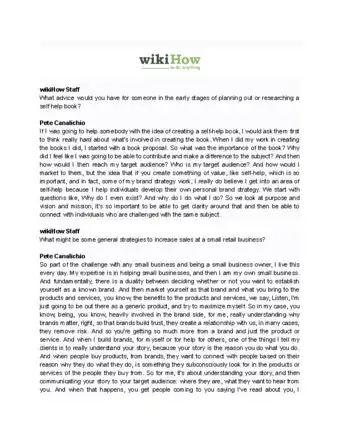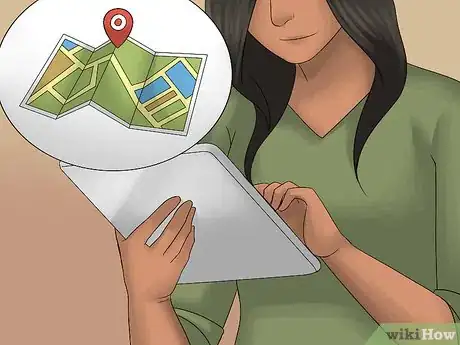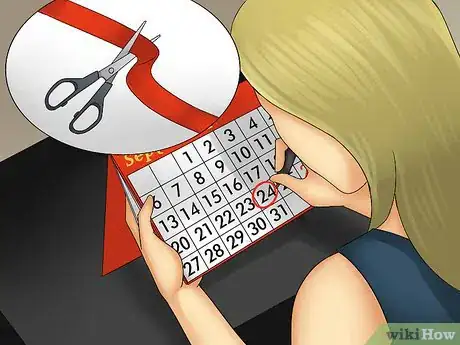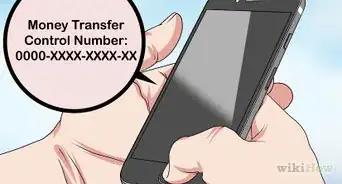This article was co-authored by Pete Canalichio. Pete Canalichio is a Brand Strategist, Licensing Expert, and Founder of BrandAlive. With nearly 30 years of experience at companies such as Coca-Cola and Newell Brands, he specializes in helping brands find the most authentic parts of their story to build a brand strategy. Pete holds an MBA from the University of North Carolina at Chapel Hill and a BS in Physics from the United States Naval Academy. In 2006, he won an MVP Award from Newell Brands for his contributions to their Global Licensing department. He’s also penned the award-winning book, Expand, Grow, Thrive.
wikiHow marks an article as reader-approved once it receives enough positive feedback. In this case, several readers have written to tell us that this article was helpful to them, earning it our reader-approved status.
This article has been viewed 135,879 times.
If you love weddings and have a sense of style, opening a bridal salon can be a rewarding and lucrative endeavor. Brides to be and their wedding parties spend a lot of money on bridal gowns and wedding accessories for the special day. Brides will also travel to certain shops for the perfect gown, and the perfect shopping experience. Your bridal shop will need to cater your clients’ needs and provide excellent customer service to start on the right foot.
Steps
Researching the Bridal Market
-
1Visit wedding fairs. Wedding fairs are events that host wedding vendors and sellers, with products ranging from dresses to veils to His and Her bridal robes, for the general public. They are also a good place to get a feel for the bridal industry, including popular styles and trends, as well as timeless accessories or styles.[1]
- Look for wedding fairs in your area or city. Bring a pen and paper to take notes as you walk through the vendor stalls. Ask vendors questions about their most popular styles and the current trends in bridal wear.
- One of the big challenges of starting a bridal shop is keeping up with current trends in the industry. Get a head start by doing your research to ensure you know what brides are looking for.
-
2Talk to family, friends, and peers about their experiences. If you have any family, friends, or peers who have recently gotten married or who plan to get married, ask them about their experiences with purchasing their wedding dress and their wedding accessories.[2]
- Ask them if there is an item they wished they could purchase or a style they wanted to have at their wedding, but couldn’t find.
- For example, one entrepreneur started her business after she planned her own wedding. She wanted a matching hoodie/pant set while getting ready for her big day, but many of the available products didn’t match her personality or style. So she developed a line of getting ready attire for brides that featured edgier and more fashion-forward styles.[3]
Advertisement -
3Look at bridal shops you admire or consider a competitor. Check the websites of designer bridal shops in your area that you find appealing. Think about how an existing shop’s aesthetic and style matches with your ideas for your shop. You may also come across shops in your area that could be a competitor. Think about how you would style or run your shop differently and what would make your shop stand out from your competitors.
- Look at the branding and marketing of other shops. Do they focus on a certain demographic or a certain bridal look? Do they have a brick and mortar location, as well as a web store? How do they get information out to their clients? Using social media tools can bring attention to your shop and boost sales. Many shops are taking advantage of the large buying presence on the internet and expanding their marketing to social media and online platforms.
-
4Decide if you are going to be a brick and mortar shop or an online shop. Some shops are purely web-based, so they pay for hosting their website and communicate with their clients online. Other shops only have a brick and mortar shop, with a limited web presence. Think about whether you would like to maintain just a webshop or own an actual shop.[4]
- Most successful bridal shops have a physical location and a healthy web presence. This combination allows bridal shops to offer one on one fittings and face to face customer service, while still communicating and networking with clients online.
-
5Understand the day in the life of a bridal shop owner. For most bridal shop owners, their days are spent focusing on the needs of their clients, the managing of their inventory, and the general running of the store. A typical day as a bridal shop owner might include:
- Booking appointments for brides and their families to help them find the right dresses and catering to their needs. Depending on how large your staff is, you will work directly with your clients or check on them to see if your employees are giving them the help they need.
- You will also communicate with fashion houses and distributors to ensure dresses are delivered on time and on budget.
- You may use an in-house seamstress or outsource your tailoring to a third party service. Regardless, you will need to check on any outstanding alterations to make sure they are done on time.
- At the end of the day, you will record the day’s payments and check your finances to ensure your shop’s profit margins are in order.
Organizing Your Finances
-
1Get professional financial advice. Look for free general business advice from associations like Business Link, the Federation of Small Businesses (FSB) and Independent Retailers Associations in your area or city. You can also talk to a financial advisor at your bank about starting a small business and the financial tools needed to do this.[5]
- You may also seek out a mentor, someone who currently owns a bridal shop in your area or who you feel may be a good guide and role model. Ask this mentor if you can shadow her for a few days or get advice on how to start your own bridal business.
- Some shop owners start as employees at a bridal shop and work under a mentor for several years before opening their own shop. This way, they are familiar with the financial requirements and the current bridal trends to then start their own business.
-
2Create a business plan. Your business plan should act as your shop’s roadmap or master template. A good business plan will prove to investors your business is viable and has the potential to be successful. A business plan should analyze your business, its market, and its plan going forward for several years. Your bridal shop business plan should include:[6]
- A general business description: This should include the name of your business, for example, Carrie’s Bridal Boutique, the city where your business will be located, a proposed location for your business, and your customer type.
- Inventory description, analysis, and strategy: This section should list your planned inventory, for example, “wedding gowns, headpieces, jewellery, shoes, and tuxedo rentals.” It should also elaborate on your client demographic and why your proposed business location will be profitable for your business. For example, “The majority of Carrie’s Bridal Boutique’s clients will be from the local downtown area of Portland, with a hip and current aesthetic.” It should also look at your local and regional competitors, as well as how your business will compete against these businesses.
- Promotion plan: Though you may want to create a separate, more extensive marketing plan, your business plan should include a breakdown on how you plan to market your shop. You can do a month to month list of any promotional events or specials you will do, such as a “Fall Wedding Promotion” or an “Early Prom Tux Sale.”
- Future plans: This section should address how you are going to take your business from a startup to a success. This could be maintaining a consistent promotional and pricing strategy for two years, followed by expanding to high selling lines and honing stock based on profit margins and what is selling well.
- Resume: This should be presented in a professional manner, with a list of your qualifications, previous work experience, and education.
- Start-up expenses: These should be broken down to the dollar and then rounded up. You should have expenses listed for in-store stock, office supplies, and shop supplies (including first month’s rent), as well as a total amount for your start-up expenses. You will use this amount to apply for financing through loans, grants, and investments.
- Projected statement of sales and expenses: These should be hard number that show potential sales and expenses for your first year in business. You should estimate your net sales, expenses, and net profit.
-
3Determine if you need a loan. Once you complete your business plan, decide if you will need a loan to finance the start-up costs of your business. Talk to your financial advisor at your bank to determine how much money you might qualify for.[7]
- You can also look at other ways to finance your business, such as savings or equity in your home. You may also quality for business grants through specific organizations or non-profits.
-
4Get an accountant. An accountant can help you organize your finances, prepare loan applications and ensure your bookkeeping is in order.
- You can also try to do your own bookkeeping by learning how to use QuickBooks through a training course, but in the long term, you may want to invest in a good accountant.
-
5Create a marketing plan. Think about your ideal client, and what she or he looks like. Your store may be geared towards a certain body shape, such as plus-sized or big busted, or it may focus on a certain demographic, such as younger, hipper brides. Try to have an ideal client in mind as you start to plan and organize your bridal store. This will give your store a unique look and ensure you are marketing towards a specific customer.[8]
- Think about how you will advertise your shop. Print magazines are popular with some bridal suppliers, especially advertisements in bridal magazines. Check out bridal, fashion, and beauty features in local press in your area and think about putting ads in these sections.
- Your website should have keywords in the copy to attract brides to your site when they are searching for bridal shops. List your suppliers with a direct link to their websites so a bride can see the complete collection she may be able to purchase from you.
- In store promotions, especially on a monthly basis and seasonally (for example, prom promos or Christmas wedding specials), are also great for generating sales and encouraging clients to return to your store.
- Your marketing plan should also focus on the customer experience, as well as the inventory and styles you will stock in your store. Most customers who are shopping for bridal attire are in it for the products and the way they are treated, with a desire to have a fun, pampered, and hands-on shopping experience. Good customer service is a big selling point for many clients and can work just as well, or better, than an extensive ad campaign.
Setting Up Your Shop
-
1Find a store location. Don’t stress about finding a location on a high street or in a designer fashion district. If you build a reputation, brides will travel to find the perfect dress and the perfect shopping experience. Rent will likely be cheaper in a secondary or less trendy location. But ensure the location is near other fairly reputable business, gets some foot traffic, and has parking available nearby.[9]
- Contrary to popular belief, having no competition in the area may not be a good thing. If there is more than one bridal shop in the vicinity, a bride may be more keen to come to the area and spend the day shopping for a dress in several different shops.
- Avoid a space with two floors as your rent will be high and you will need to hire more staff. Look for a premise with a five year lease and a three year break lease clause. This will give you time to establish your business and build up your reputation in the industry. After two years in business, you should have a good idea of how you are doing and if your business will be profitable enough to last for the next three years, or if you may need to break your lease in the next year.
-
2Decorate the shop. Once you have your location, decide how you are going to furnish and decorate it. You should have basic supplies and materials like clothing racks, display counters, and large dressing rooms with large mirrors. You may also want to include comfortable seating areas and strategic lighting.[10]
- Make the showroom inviting and intimate with plug in scents, low music on a sound system, and fresh flowers. Create a space where you can chat with clients and their families, and feel confident making a sale.
- You should also buy a computer with sales software, like a point of sales system (POS). This will make ringing in sales faster and easier, and ensure you can accept most major credit cards.
-
3Order your inventory. To bring inventory into your shop, you will need to select suppliers. Avoid any designers that are already stocked by your competitors. Most designers will not want to supply you if they already have successful stock lists in your area.[11]
- Start with four collections, and 40 to 50 samples total. Purchase a good representation of designs from each supplier.
- Stock products in a range of price bands. But don’t underprice or overprice yourself for your area. If most bridal shops have gowns in a range of $500-$1,000, don’t go under this range and only stock a few pieces over this range.
- Building up a relationship with your suppliers is fundamental to the success of your business. If you are loyal to them, and their pieces sell in your shop, you can expect loyalty from them in return. Over time, some designers may offer exclusivity to your shop, but you will need to sell a high amount of their gowns every year and continue to sell their products at a high rate for this to happen.
-
4Hire your staff. If your location is small, you may only need to hire one or two employees. Consider how often you want to be in the shop, handling the day to day business, and if you can afford to hire more than one employee. If you have a larger showroom, or a large client list, you will likely need to hire more employees to keep up with client demand.[12]
- Screen applicants by looking closely at their resumes for relevant customer service experience and comfort working with people. During the job interview, ask them about their previous work experience and have them demonstrate their ability to interact with customers.
-
5Promote the shop through social media and advertising. Several weeks before opening day, post updates on the store opening to your social media accounts (Twitter, Tumblr, Facebook, Instagram), and do an update blog on your website. You can also take out advertisements in local publications in your area to announce the opening day.[13]
- You may decide to hold a promotion for the first 100 customers in the store on opening day, or a discount on a certain item or product during opening week. Encourage clients to visit your store as soon as you open by offering special pricing and pushing your advertising to get the word out.
-
6Get ready for opening day. According to the industry, the best time to open a new shop is in September, as most brides will start looking for their wedding one year ahead. January is also a good time as brides getting married later the same year will start looking for wedding attire then.[14]
- Keep your operating hours simple and consistent, such as Monday to Friday, 10-5, and Saturdays, 9-5. Look at the operating hours of the shops around you and try to match their hours.
- Over time, you may tweak your opening hours based on the frequency of your customers on a certain day of the week or time.
Expert Q&A
-
QuestionHow do you build an effective brand?
 Pete CanalichioPete Canalichio is a Brand Strategist, Licensing Expert, and Founder of BrandAlive. With nearly 30 years of experience at companies such as Coca-Cola and Newell Brands, he specializes in helping brands find the most authentic parts of their story to build a brand strategy. Pete holds an MBA from the University of North Carolina at Chapel Hill and a BS in Physics from the United States Naval Academy. In 2006, he won an MVP Award from Newell Brands for his contributions to their Global Licensing department. He’s also penned the award-winning book, Expand, Grow, Thrive.
Pete CanalichioPete Canalichio is a Brand Strategist, Licensing Expert, and Founder of BrandAlive. With nearly 30 years of experience at companies such as Coca-Cola and Newell Brands, he specializes in helping brands find the most authentic parts of their story to build a brand strategy. Pete holds an MBA from the University of North Carolina at Chapel Hill and a BS in Physics from the United States Naval Academy. In 2006, he won an MVP Award from Newell Brands for his contributions to their Global Licensing department. He’s also penned the award-winning book, Expand, Grow, Thrive.
Brand Strategist & Licensing Expert Make sure that you really understand your brand's story, and that you're able to communicate that story to your target audience. Once you do that, you get people approaching your business with interest since they have a good idea of who you are and what you stand for.
Make sure that you really understand your brand's story, and that you're able to communicate that story to your target audience. Once you do that, you get people approaching your business with interest since they have a good idea of who you are and what you stand for. -
QuestionHow can you start a business with little or no money?
 Pete CanalichioPete Canalichio is a Brand Strategist, Licensing Expert, and Founder of BrandAlive. With nearly 30 years of experience at companies such as Coca-Cola and Newell Brands, he specializes in helping brands find the most authentic parts of their story to build a brand strategy. Pete holds an MBA from the University of North Carolina at Chapel Hill and a BS in Physics from the United States Naval Academy. In 2006, he won an MVP Award from Newell Brands for his contributions to their Global Licensing department. He’s also penned the award-winning book, Expand, Grow, Thrive.
Pete CanalichioPete Canalichio is a Brand Strategist, Licensing Expert, and Founder of BrandAlive. With nearly 30 years of experience at companies such as Coca-Cola and Newell Brands, he specializes in helping brands find the most authentic parts of their story to build a brand strategy. Pete holds an MBA from the University of North Carolina at Chapel Hill and a BS in Physics from the United States Naval Academy. In 2006, he won an MVP Award from Newell Brands for his contributions to their Global Licensing department. He’s also penned the award-winning book, Expand, Grow, Thrive.
Brand Strategist & Licensing Expert Get help from people in organizations that charge little to nothing. The Small Business Administration is a good place to start, because they have locally-provided services. These are typically seasoned experts who are either retired or in a second career, and they're coming back to help individuals start their businesses. You could also join entrepreneurial groups—all the members have shared needs and a lot of similarities, so you can learn from one another.
Get help from people in organizations that charge little to nothing. The Small Business Administration is a good place to start, because they have locally-provided services. These are typically seasoned experts who are either retired or in a second career, and they're coming back to help individuals start their businesses. You could also join entrepreneurial groups—all the members have shared needs and a lot of similarities, so you can learn from one another. -
QuestionHow do I reach bridal gown and accessories suppliers?
 Community AnswerCheck their websites, e-mail, or call them based on the information that you can find on their website.
Community AnswerCheck their websites, e-mail, or call them based on the information that you can find on their website.
Expert Interview

Thanks for reading our article! If you'd like to learn more about being an entrepreneur, check out our in-depth interview with Pete Canalichio.
References
- ↑ https://bridalbuyer.com/home/home/starting-or-enhancing-a-bridal-business
- ↑ https://bridalbuyer.com/home/home/starting-or-enhancing-a-bridal-business
- ↑ http://www.entrepreneur.com/article/201668
- ↑ https://www.shopify.com/success-stories/shop-lovely
- ↑ https://bridalbuyer.com/home/home/starting-or-enhancing-a-bridal-business
- ↑ http://www.referenceforbusiness.com/business-plans/Business-Plans-Volume-06/Bridal-Salon-Business-Plan.html
- ↑ https://bridalbuyer.com/home/home/starting-or-enhancing-a-bridal-business
- ↑ http://www.bplans.com/bridal_shop_business_plan/market_analysis_summary_fc.php#ixzz3e0zei0bb
- ↑ https://bridalbuyer.com/home/home/starting-or-enhancing-a-bridal-business
- ↑ https://bridalbuyer.com/home/home/starting-or-enhancing-a-bridal-business
- ↑ https://bridalbuyer.com/home/home/starting-or-enhancing-a-bridal-business
- ↑ https://bridalbuyer.com/home/home/starting-or-enhancing-a-bridal-business
- ↑ https://bridalbuyer.com/home/home/starting-or-enhancing-a-bridal-business
- ↑ https://bridalbuyer.com/home/home/starting-or-enhancing-a-bridal-business
About This Article
To start a bridal shop, create a detailed business plan that includes a business description, inventory strategy, start-up expenses, projected sales, and marketing ideas. Next, select a location and furnish it with clothing racks, comfortable seating areas, display counters, large mirrors, and strategic lighting. You should also buy a computer with sales software, like a point of sales system (POS). Then, order inventory in a range of price points and hire your staff. Finally, start promoting your opening through ads and on social media! For tips on how to handle bookkeeping, read on!














































































